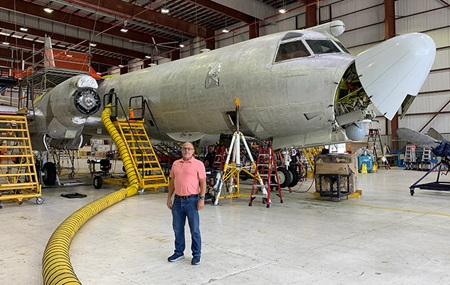By Pedro Torres and Rhonda Hewitt
Pedro is quick to point out that in all his time working in aviation maintenance, no two days have ever been the same. And that’s what he loves most about his career choice.
Pedro’s passion for this work began with a career in the U.S. Navy where he was first an aviation mechanic and later an aviation electrician. In 2022, he retired from the Navy following 22 years of service and joined Northrop Grumman as the operations manager for the Aircraft Maintenance and Fabrication Center in Lake Charles, Louisiana.
Pedro and his 34 team members perform maintenance on P-3 aircraft. The team literally breaks the plane apart — stripping the paint and conducting an in-depth inspection. The process may take up to 270 days.
Here, Pedro shares one of his Monday mornings.
4 a.m. Yes, I’m an early riser! I’ll usually grab a ham and cheese sandwich before heading to the facility. My wife, Hianda, is up and exercising by the time I leave around 4:15 a.m.
4:45 a.m. I’m typically the first to arrive. I enjoy being here before team members begin arriving at 6 a.m. On Monday morning I review our schedule. There’s always one, sometimes two, aircraft on the floor, and my goal is to keep our team ahead of schedule. We have delivery dates on every aircraft, and it’s crucial to stay ahead of schedule to ensure we don’t jeopardize our contract delivery date.
5:30 a.m. I meet with the floor manager and review the weekly goals. This helps keep us ahead of the planned schedule. Together we assign specific tasks that need to take place throughout the week.
One of the processes that I put in place was to display the schedule on the manufacturing floor. This ensures that everyone — whether they’re working on flight control installations or involved in the paint process — sees the goal line. They understand their role and purpose on the project.
6 a.m. We gather for our full team meeting, during which we assign tasks and discuss any issues. Many members are new to working on P-3 aircraft, so we also discuss who may need training on an assignment. Much of my day involves training teammates, so I make a point of knowing how to perform every task that’s being assigned.
7 a.m. Next is the “hotwash” where I meet with my team leads to review any discrepancies — such as an issue with parts or documents needing more information — that have come up and adjust our schedule accordingly.
9 a.m. I spend the balance of my morning on the factory floor. I enjoy doing a lot of hands-on teaching, everything from replacing parts to replacing engines. Fortunately, I was trained as an instructor in general aviation maintenance and aviation maintenance management when I was in the service.
These walk-arounds give me an opportunity to chat with team members to get to know them better, observe them at work and reinforce safety protocol and procedures. I regularly move members around so that they’re learning different tasks. This provides flexibility to ensure all roles are covered.
11:30 a.m. We break for lunch, which is often a potluck. Every other week, the managers cook for everyone. The favorite on the floor is when I cook my coffee cardamom smoked beef brisket. It’s a hit!